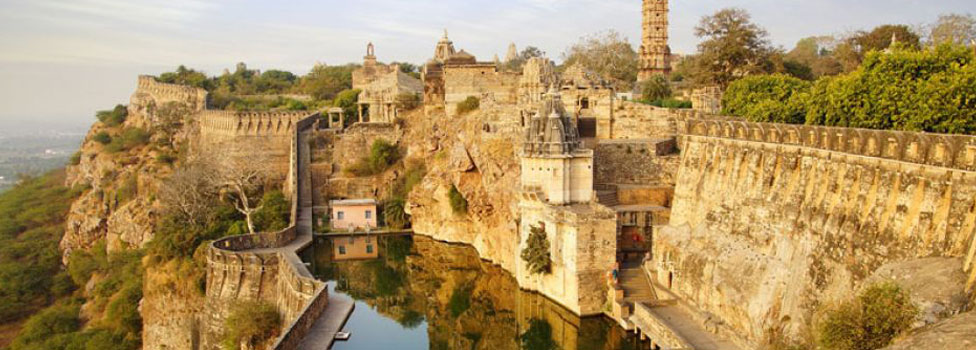The great, battle-scarred Chittorgarh Fort epitomizes in its tragic history the valor, romance, chivalry and strict death-before-dishonor code glorified in Rajput myths and legends. Sprawling across 280 ha, atop a steep 180 m high rocky hill, Chittorgarh’s ruined palaces, temples and towers bear witness to its illustrious and turbulent past, when it was the capital of the Sisodia rulers of Mewar, between the 12th and 16th centuries.
As Rajasthan’s mightiest forts, it was the target of successive invaders. The first siege, in 1303, was by Sultan Alauddin Khilji, whose goal was to capture not only the fort but also the queen, Rani Padmini, whose legendary beauty the sultan had glimpsed reflected in a mirror. When defeat seemed inevitable, Rani Padmini along with 13,000 women committed jauhar – a ritual form of mass suicide by immolation, practiced by Rajput women to escape dishonor at the hands of their enemies. It is said that 50,000 Rajput warriors died in the ensuing battle. Alauddin’s army then proceeded to sack the fort and destroy many of its buildings. Within a few years, however, the ruler’s grandson had regained it for the Sisodia dynasty.
The next great battle, this time against Sultan Bahadur Shah of Gujarat in 1535, saw the Queen Mother, Rani Jawaharbai, lead a cavalry charge and die on the battle-field along with the flower of Rajput youth. Once again, thousands of women inside the fort committed jauhar. The third and final assault on Chittorgarh was led by the Mughal emperor Akbar, who was able to capture it in 1567. Chittorgarh was abandoned thereafter, and the Sisodias moved their capital to Udaipur.
Exploring the Chittorgarh Fort
Seven massive spiked gates lead to the fort. The first building to the right is Rana Kumbha’s Palace, probably the earliest surviving example of a Rajput palace. Its northern side has a profusion of richly carved balconies, and a unique stepped wall. Elephant stables and a council chamber comprise its public areas, while the private apartments are a maze of small rooms, including a zenana section. Near it are the 20th century Fateh Prakash Palace, which now houses a museum of sculpture found on the site; the Kumbha Shyam Temple, dating to the 15th century, with a fine sculpture of Vishnu in his Varaha incarnation; and the Meerabai Temple, built in 1440 by Meerabai, another remarkable Mewar queen. A mystic and a poetess, she defied Rajput convention and devoted her life to the worship of Lord Krishna.
The main street runs south of this temple towards the nine-storeyed Vijay Stambh, built by Maharana Kumbha between 1458 and 1468, to commemorate his victory over Sultan Mahmud of Malwa. The view from the top of this extraordinary 36 m high sandstone structure, richly carved with gods and goddesses, is magnificent. The main street continues further south past noble-men’s mansions to the Gaumukh Reservoir, fed by an underground spring, and the 16th century Kalika Mata Temple, built over the original Sun Temple which was destroyed during the devastating siege of 1303.
Opposite this temple stands the 19th century reconstruction of Padmini’s Palace with a lake pavilion adjacent to it. The palace contains the mirror in which Alauddin Khilji supposedly saw her reflection. Standing further south, past some Jain temples, is the Kirti Stambh. This seven-storeyed tower is dedicated to the first Jain tirthankara, Adinath
How to reach the Chittorgarh Fort
By Air
Nearest airport is Dabok Airport, Udaipur, well-connected to Delhi, Mumbai, Jodhpur and Jaipur by daily flights.
By Rail
Chittorgarh Station is linked to Delhi by the Nizamuddin-Udaipur Express and to Jaipur by the Mewar Express. There are some other good options between Udaipur and Chittorgarh.
By Road
NH8 connects Jaipur and Delhi to NH79 at Ajmer, along which Chittor is a 3.5 hr drive away via Nasirabad and Bhilwara.
Chittorgarh Fort


